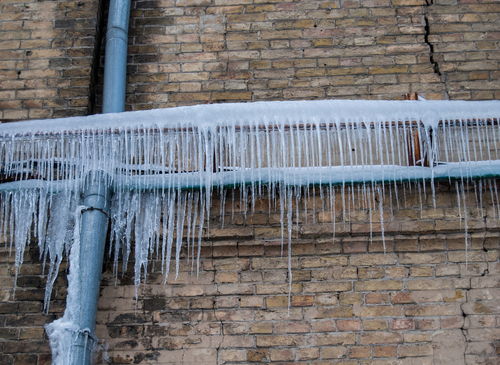Everyone maintains their private way of thinking when it comes to Preventing and dealing with frozen pipes.

Winter can ruin your plumbing, specifically by freezing pipelines. Below's exactly how to stop it from happening and what to do if it does.
Intro
As temperatures drop, the threat of icy pipes increases, potentially resulting in costly repair services and water damages. Comprehending exactly how to avoid frozen pipes is essential for property owners in chilly climates.
Avoidance Tips
Protecting at risk pipelines
Cover pipelines in insulation sleeves or make use of warmth tape to shield them from freezing temperature levels. Concentrate on pipelines in unheated or outside locations of the home.
Heating methods
Maintain interior spaces sufficiently warmed, specifically locations with plumbing. Open cabinet doors to permit cozy air to flow around pipes under sinks.
Just how to determine icy pipes
Search for decreased water circulation from faucets, unusual odors or sounds from pipes, and noticeable frost on exposed pipes.
Long-Term Solutions
Architectural modifications
Take into consideration rerouting pipelines far from outside walls or unheated locations. Include additional insulation to attic rooms, basements, and crawl spaces.
Updating insulation
Purchase high-grade insulation for pipes, attic rooms, and wall surfaces. Proper insulation helps preserve regular temperature levels and lowers the threat of icy pipelines.
Safeguarding Exterior Plumbing
Garden tubes and outdoor faucets
Separate and drain pipes yard pipes prior to winter. Set up frost-proof faucets or cover outdoor faucets with shielded caps.
Recognizing Icy Pipelines
What triggers pipes to ice up?
Pipes freeze when subjected to temperatures listed below 32 ° F (0 ° C) for prolonged periods. As water inside the pipes ices up, it expands, putting pressure on the pipeline walls and possibly causing them to burst.
Risks and problems
Frozen pipes can bring about water system disturbances, residential or commercial property damages, and expensive repair services. Burst pipelines can flood homes and cause extensive structural damage.
Signs of Frozen Pipes
Determining frozen pipelines early can stop them from bursting.
What to Do If Your Pipelines Freeze
Immediate activities to take
If you presume icy pipelines, maintain faucets open up to alleviate stress as the ice thaws. Make use of a hairdryer or towels taken in warm water to thaw pipelines gradually.
Verdict
Stopping icy pipes requires proactive procedures and fast actions. By recognizing the causes, indicators, and safety nets, property owners can protect their plumbing during winter.
6 Proven Ways to Prevent Frozen Pipes and Protect Your Home
Disconnect and Drain Garden Hoses
Before winter arrives, start by disconnecting your garden hoses and draining any remaining water. Close the shut-off valves that supply outdoor hose bibs and leave the outdoor faucet open to allow any residual water to drain. For extra protection, consider using faucet covers throughout the colder months. It’s also important to drain water from any sprinkler supply lines following the manufacturer’s directions.
Insulate Exposed Pipes
Insulating your pipes is an effective way to prevent freezing. Pipe insulation is readily available at home improvement stores and is relatively inexpensive. Pay close attention to pipes in unheated areas such as the attic, basement, crawl spaces, or garage. Apply foam insulation generously to create a buffer against the cold. You can also wrap your pipes in heat tape or thermostat-controlled heat cables for added warmth.
Seal Air Leaks
Inspect your home for any cracks or openings that could let in cold air. Seal any holes around the piping in interior or exterior walls, as well as the sill plates where your home rests on its foundation. Additionally, make sure to keep your garage door closed unless you’re entering or exiting. Leaving it open creates a significant air leak that can lead to frozen pipes.
Allow Warm Air Circulation
During cold snaps, it’s essential to allow warm air to circulate evenly throughout your home. Leave interior doors ajar to promote better airflow. Open kitchen and bathroom cabinets to help distribute heat consistently around the rooms. If you have small children or pets, be sure to remove any household chemicals or potentially harmful cleaners from open cabinets for safety.
Let Faucets Drip
A small trickle of water can make a big difference in preventing ice formation inside your pipes. When temperatures drop significantly, start a drip of water from all faucets served by exposed pipes. This continuous flow helps prevent the water from freezing. Additionally, running a few faucets slightly can relieve pressure inside the pipes, reducing the chances of a rupture if the water inside does freeze.
https://choateshvac.com/6-proven-ways-to-prevent-frozen-pipes-and-protect-your-home/

As a fervent person who reads about Prevent Frozen Pipes , I thought sharing that article was worth the trouble. Remember to pause to share this post if you enjoyed it. Kudos for your time. Kindly check up our blog back soon.
Click Here